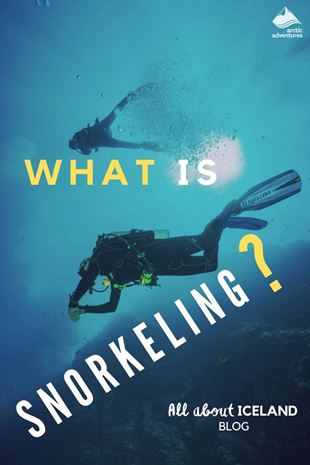
Snorkeling vs. Scuba Diving: What’s the Difference?
The Silfra Fissure in Southwest Iceland is considered one of the best snorkeling and diving spots on Earth.
Snorkeling is a rewarding activity you can do year-round at sites like the Silfra Fissure in Iceland. It’s totally safe and almost anyone can do it.
Snorkeling in Iceland is one of the most rewarding activities you can do year-round at Silfra Fissure. It’s totally safe and almost anyone can do it.
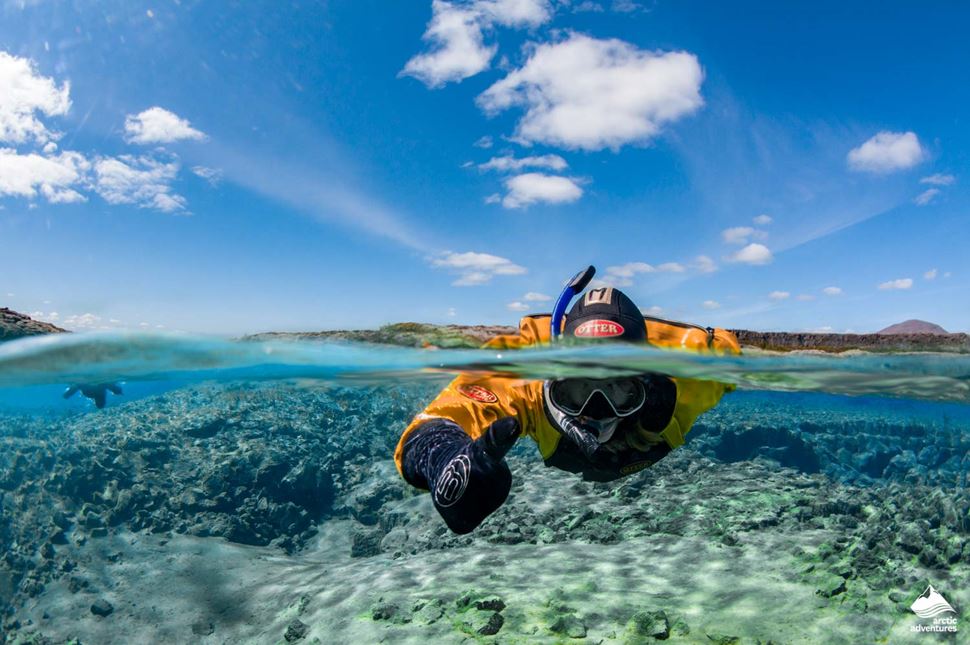
Snorkeling in clear water
Before you jump in the water for your snorkeling adventure, there are a few basic things you need to know. If you’re a total beginner, this guide to snorkeling will be really useful to you. Learn all the essentials and prepare yourself for the experience of snorkeling in Iceland.
Snorkeling is often something that you either know a lot or very little about, with some beginners questioning the difference between snorkeling and scuba. To get you started, we’ve broken it down for you:
Snorkeling: Snorkeling is an underwater activity that involves a breathing tube. A mask is a common add-on so you can see more effectively underwater. Snorkeling allows the exploration of underwater scenery and landscapes not visible from the water’s surface without the worry of oxygen intake.
Plus, it’s so simple — almost anyone can do it. All you need is a mask and a snorkel tube!
While there are a number of locations for snorkeling in Iceland, snorkeling can mainly be done at Silfra Fissure. Silfra is a water-filled crack between the North American and Eurasian tectonic plates. Nowhere else on Earth can you snorkel between two continental plates! Check out what to know before snorkeling at Silfra in our blog.
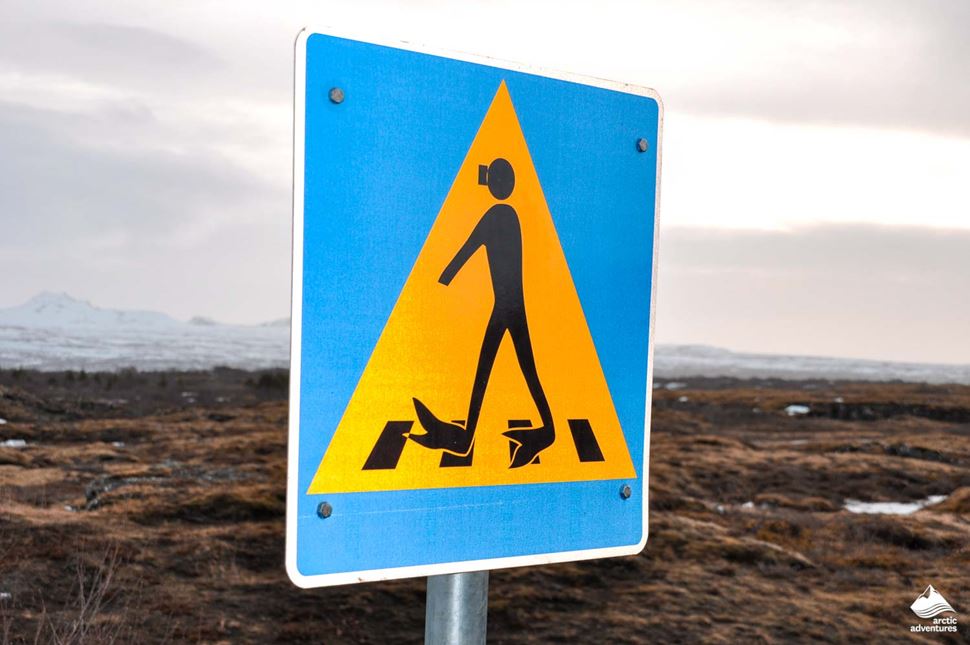
Sign at Silfra Fissure in Iceland
Silfra Fissure was recently named as one of the top activities in the world by TripAdvisor. It’s a great way to make your time in Iceland more exciting, particularly if you’re planning to embark on the Golden Circle!
So now you know what snorkeling is, here are a few great ways to get the most out of the fun.
Almost anyone can try snorkeling. But to make the most of it, you should get some basic preparation under your belt.
Being a confident swimmer will mean that your snorkeling experience is much more relaxing. While you don’t really need to swim powerfully at Silfra Fissure as the glacier water gently guides you along its current, it never hurts to know how to swim!

Knowing how to swim means you’re more flexible, mobile, and safer in the water. A strong kicking technique is perhaps the most key element to master before heading out with a snorkel and will mean you can focus on the fascinating scenery. Iceland’s swimming pools are great places to practice.
Breathing with a snorkel might take some getting used to, as it’s a little different from regular breathing. While using a tube to get air and swimming, you’ll be getting less air than your body is used to. Swimming will mean you’re exerting yourself, but you’ll need to keep your breathing steady and stable, which can be easier said than done. It might take some practice even before you get in the water.
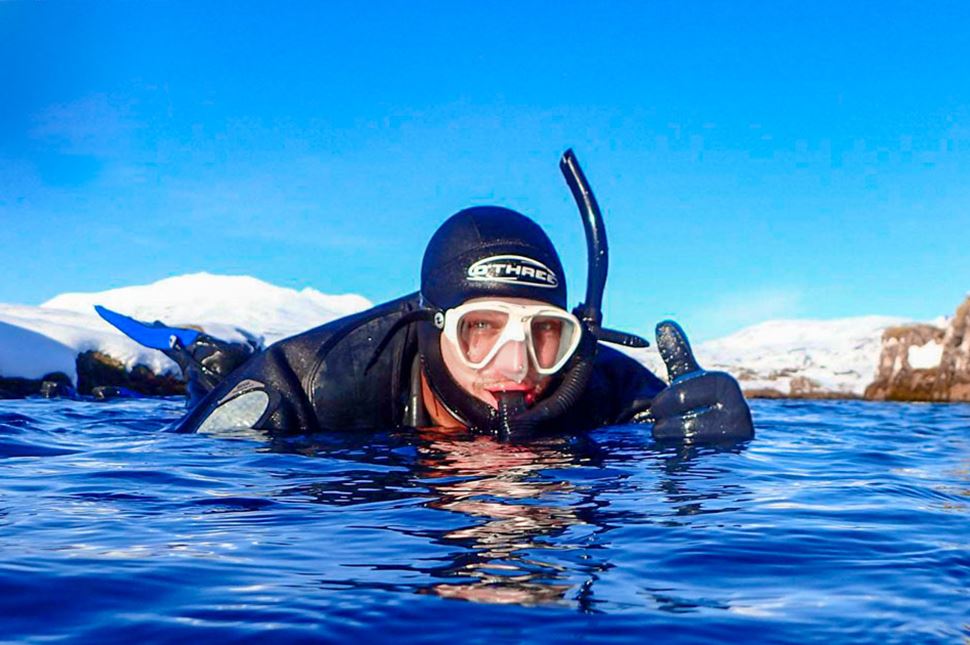
Snorkeler at Silfra Fissure during winter
You can begin mastering the correct breathing technique when still at home. Make sure you’re in a quiet place where you won’t be interrupted. Then take a large breath, and imagine filling your lungs up with air. Picture filling up your diaphragm (in the middle of your torso), then your chest, then the top of your torso. Your lungs are more likely to be filled up to capacity. This will help train your lungs to expand with air properly.
Moving through water, as you probably know, can also be a challenge if you’re not used to it. Even if you are a confident swimmer, snorkeling can take a lot out of you. Maintaining a downward-facing position and kicking with fins will mean you’re using muscles you might not typically exercise.

Snorkeling at Silfra Fissure in Iceland
Of course, don’t kick around too hard, or you might risk damaging the underwater nature. Stay eco-friendly! The important thing to remember is to stay relaxed and keep your body and breath steady and calm. The slower you go, the more fun you’ll have and the better experience you’ll have overall.
Snorkeling at Silfra is something absolute beginners can do. It’s so safe and easy, and needs no preparation!
But if you do want to practice to be a bit more comfortable in the water, we understand. The best way is to head to your local pool and take a few practice swims. Bring your snorkel mask and tube and try breathing. You’ll want to keep your arms still while your feet do most of the work, propelling you forward.
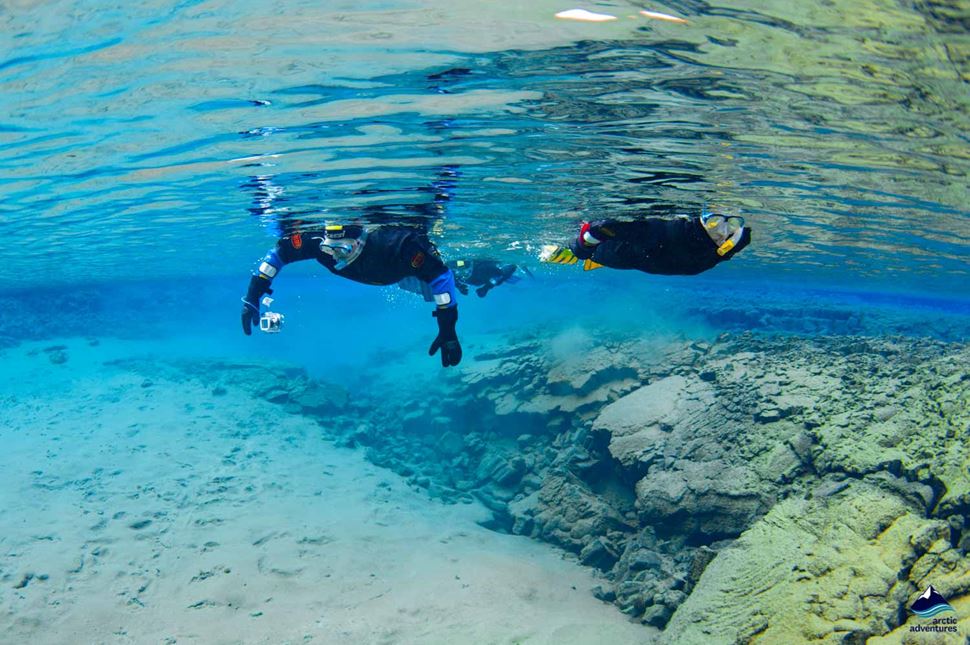
Guided snorkeling tour at Silfra Fissure in Iceland
While you’re snorkeling, you might get water in your tube. Simply blowhard and clear out all the water. You might also get air in your mask. Simply press your mask against your face, blow it out through your nose.
If you feel pressure in your ears, simply pinch your nose slightly and blow out. It will equalize the pressure and make you more comfortable in the water.
When you book a snorkel tour with Arctic Adventures, we provide all the gear you need to snorkel. If you want to know what you’ll be wearing on your snorkeling tour, here are the basics.
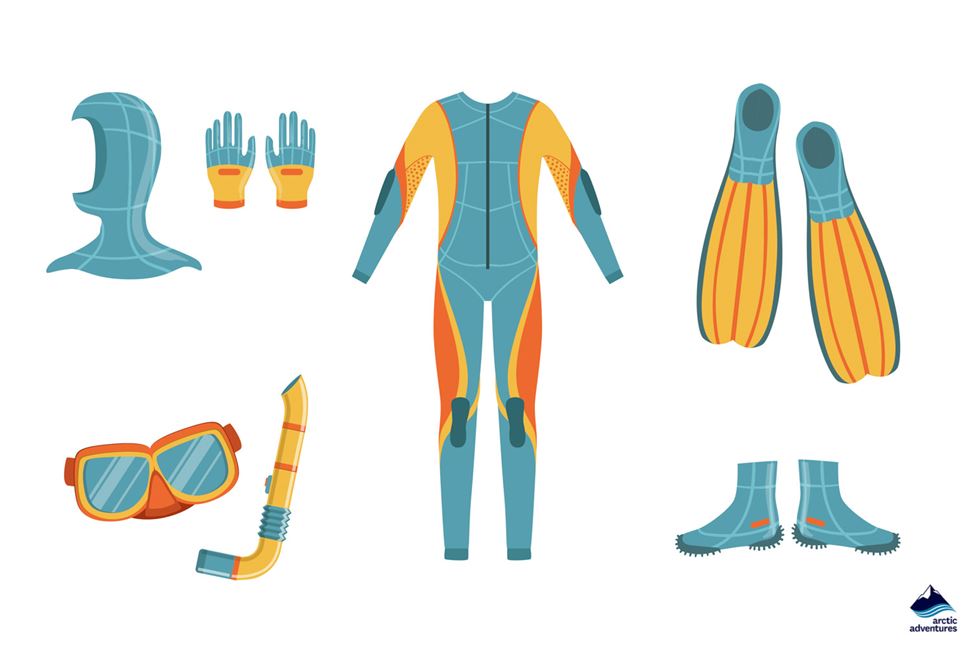
Snorkeling equipment
There are 3 types of snorkels – basic, semi-dry, and dry snorkel.
Your mouthpiece should be made of silicone. It should not move as your jaws relax.
As you put your mouthpiece in place, the tip of the snorkel should be over the crown of your head when facing down in the water. This way, the tip of the snorkel reaches its highest point and avoids water splash.
At Silfra, we’ll provide you with a snorkel mask and tube, as well as an undersuit, dry suit, hood, gloves, and fins.
Please bring: To keep yourself warm in the 2 degrees Celsius, please wear some thin thermals and warm socks as your base layer, under your drysuit!
Before any snorkel tour, you’ll usually get a safety briefing. Follow your instructor’s guidelines as closely as possible. They know the surroundings and safety issues intimately.
We know Silfra is gorgeous and you should definitely take in the whole magical experience. Just be careful not to stray too close to the rocks that you might scrape against them. There is usually enough space, but it’s a good rule to keep in mind, just in case.
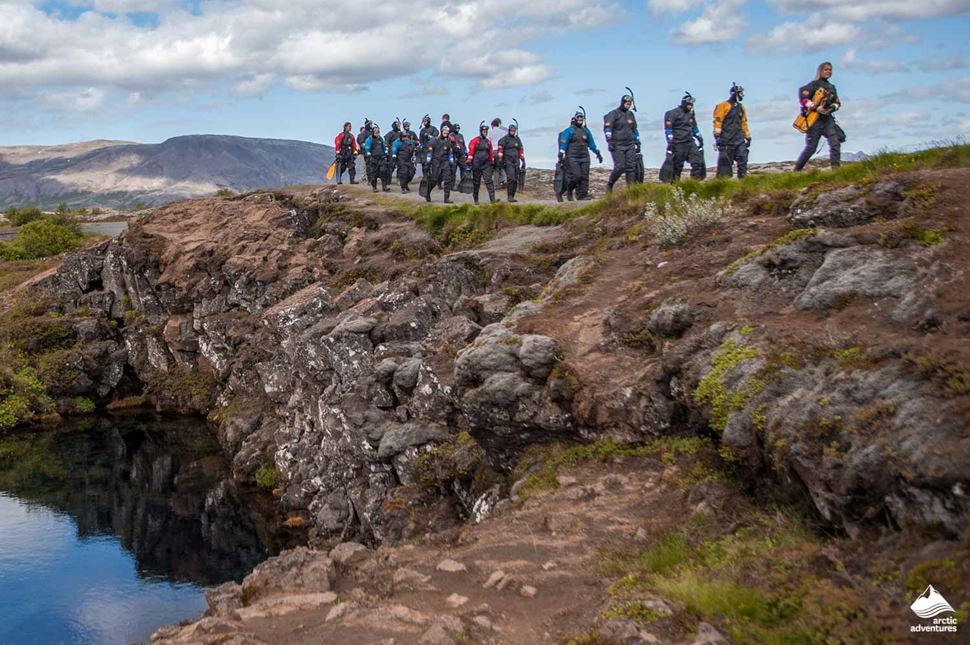
Group of people going to snorkel at the Silfra Fissure
Make sure you defog your mask so the gear won’t fog up while you’re snorkeling due to the sudden temperature change. You can do this in a few ways:
Old-fashioned spit in the mask and rub around, wash it out, and all ready to go!
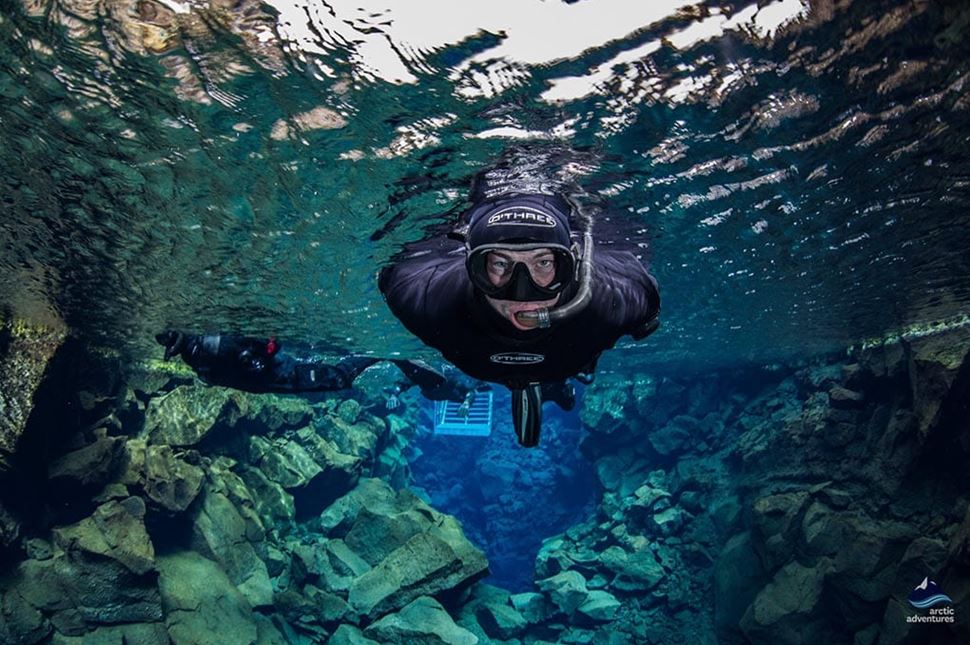
Snorkelers under the water at Silfra Fissure, Iceland
The mask straps should go above your eyes, not over your ears. Make sure there aren’t any twists on the straps. Find some more tips on what not to do in Silfra in the video below with our snorkeling guide.
Iceland, it’s fair to say, is not the first place that people think of when they hear “snorkeling”, but it should be. There is so much you can do in Icelandic waters that aren’t available on other vacations.
There’s nowhere else on the planet where you can swim between tectonic plates, nowhere with water so pure and clear that you can see for 120 m (393 ft), and nothing like swimming near a volcano or between continents.
Here are 6 things that make snorkeling in Iceland one of the most magical experiences you will ever have.
Snorkeling is traditionally associated with the tropics, as you negotiate sand, try to spot pretty fish, and share space with countless sunseekers.
Try to put that all out of your mind when you think of Icelandic snorkeling. Firstly, the landscape is stunning and distinctive (there’s a reason why the country has played other planets and mythical lands in TV and movies). This is a country of pure, clear water; possibly the freshest air you’ll ever inhale; and breathtaking glaciers and volcanoes. So even before you put on your flippers, snorkeling in Iceland is a different experience.
Once you enter the water, you’ll be transported to a part of the world that only a handful of people experience – tranquil, otherworldly, and most of all, clear.

Snorkeling tour in clear water of Silfra Fissure, Iceland
The visibility in Icelandic waters is second to none. At an astounding 70-120 meters (230-393 ft) visibility (depending on the day), Icelandic water is quite possibly the clearest on Earth. To put that into perspective, most dive sites around the world average 10-30 meters (33-98 ft) of visibility at best.
Unlike in warmer climates, Icelandic water is untouched by visibility-blurring phenomena like plankton, light sands rising to the surface, and industrial pollution. In some cases, Icelandic water is purified further after filtering through basalt rocks.
Some swimmers have said that this clarity makes the water feel like air; and that traveling through it, able to see as clearly as on the surface, is like flying.
Many of the best snorkeling sites in Iceland are freshwater. This usually means that swimmers will encounter nothing stronger than a stream or river current, as their snorkeling area is relatively sheltered from the might of the ocean.
Yes, there are more extreme arctic adventures in Iceland, some even involving water and rivers (river rafting and climbing inside a volcano for instance), but, once you can swim independently, snorkeling is easy, even meditative.
The Silfra Fissure is a rift between the North American and Eurasian tectonic plates. It’s a (relatively!) recent rift, which appeared in the 18th Century as a result of an earthquake. In fact, it’s the only place on the planet where you can swim between two tectonic plates – or two continents - and people travel from all over the world to experience it.
It’s beautiful both on land and in the water – resembling a mountain that’s been cleaved in two and then filled with the purest, bluest water on Earth.
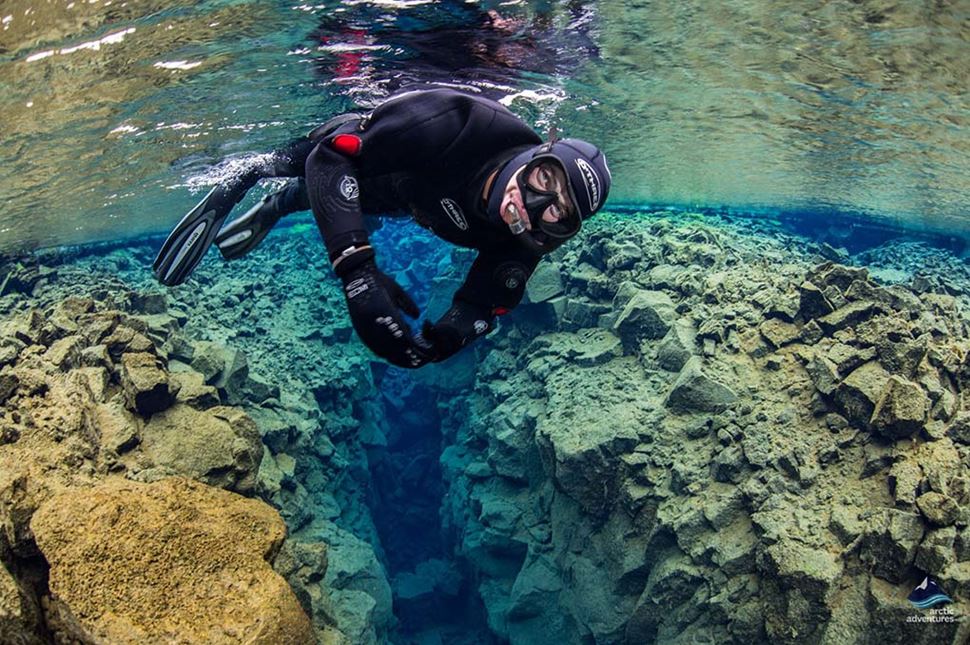
Snorkeler enjoying the tour at Silfra Fissure, Iceland
In Iceland, you will technically be in the Arctic and that is not quite the same as snorkeling in the tropics. To use an informal description, the water has a mild chill. It will be above freezing at around 35 degrees Fahrenheit, and easily comfortable enough to snorkel or dive in for 30-40 minutes (the typical swim time). That said, you will be wearing a dry suit, gloves, and hood, with only your hands and face exposed to water.
You’re unlikely to get completely wet (a dry suit serves the opposite purpose of a wetsuit!), but even if you do, the worst that should happen to you is a bit of coldness and some mild discomfort. It’s a good idea to bring a towel and a change of clothes, just in case this unlikely event comes to pass. If nothing else, bring spare socks!
Iceland has a wealth of stunning, natural attractions and theoretically, you can drive to a swim site yourself, but we wouldn’t recommend it. A local guide will know the best places to go, the best practices, what to do in case of emergency, and other key details. They’ll also provide that precious, precious dry suit!
Enlisting the help of an experienced guide, especially when snorkeling, outsources the research, worry, and logistics of your arctic adventures, leaving you free to soak up the natural splendor. You can find out more about snorkeling and diving in Iceland on our tour pages.
Ready to try snorkeling? Why not book your first snorkeling tour in Silfra today?
Best Seller
